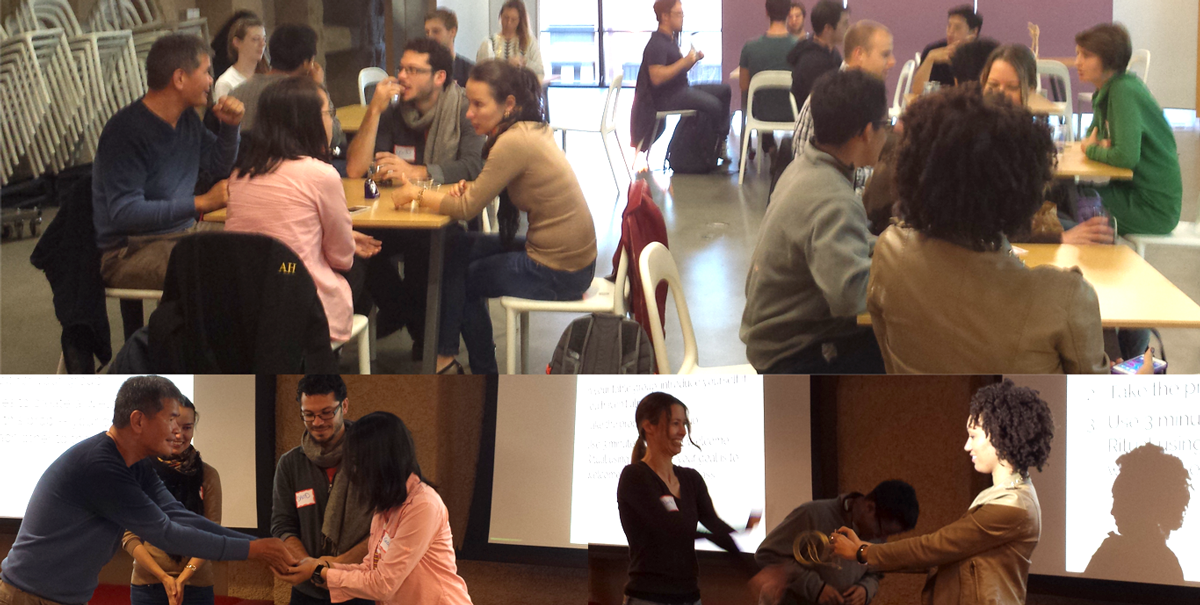
In ritual, the world as lived and the world as imagined…turn out to be the same world. -C.Geertz.
As designers, we are on a perpetual quest to make things that are meaningful and special. The people we’re trying to engage are bombarded with messages and products that promise to offer them value, that demand to be used and purchased. How can we get our design efforts to be more engaging, in this wide and clamoring sea of things? And if our users do decide to engage, then how do we offer them something that is special — rich with meaningful and memorable experiences?
We’ve observed the power of rituals — from anthropology literature to management — and thought: how can we harness this power to create better products, organizations, and experiences? Can we as designers craft new rituals, or products that support our rituals?
In our first post, we introduced the concept of ‘ritual design’, and how it might help designers create more effective experiences and how it might help a person to create strong self-narratives and achieve behavior change.
Over the past year, Margaret Hagan, Defne Civelekoglu and I ran two workshops at the Stanford d.school to explore the potential of Ritual Design. We invited undergrad and grad students interested in rituals to come together to design new ones for themselves and others. We identified four themes that could be the basis for new rituals: commuting, grooming, productivity, and eating/food. We asked all the participants to select one of the themes for designing a ritual for themselves, and to bring a prop(object) related to the theme they selected.
We ran these workshops with two overarching questions in mind: can we create new human-centered design methods to create better rituals to live (and to work) by? And how much interest is there from designers (and consumers) in crafting new rituals?
For the second question, we quickly found out the answer: there is huge interest (at least on Stanford campus). Our workshops were oversubscribed, with over a hundred students signing up to come design rituals.
For the first question, we used our own background research, and our own experiments in ritual design, to create a curriculum of methods that could be effective.
In this post, we go through the most successful of these methods, to guide future ritual designers. We also expect these methods could be of use to more general design processes that are looking to create more meaningful experiences).
Method 1. Make a list of all rituals in your life to discover what you care and value most
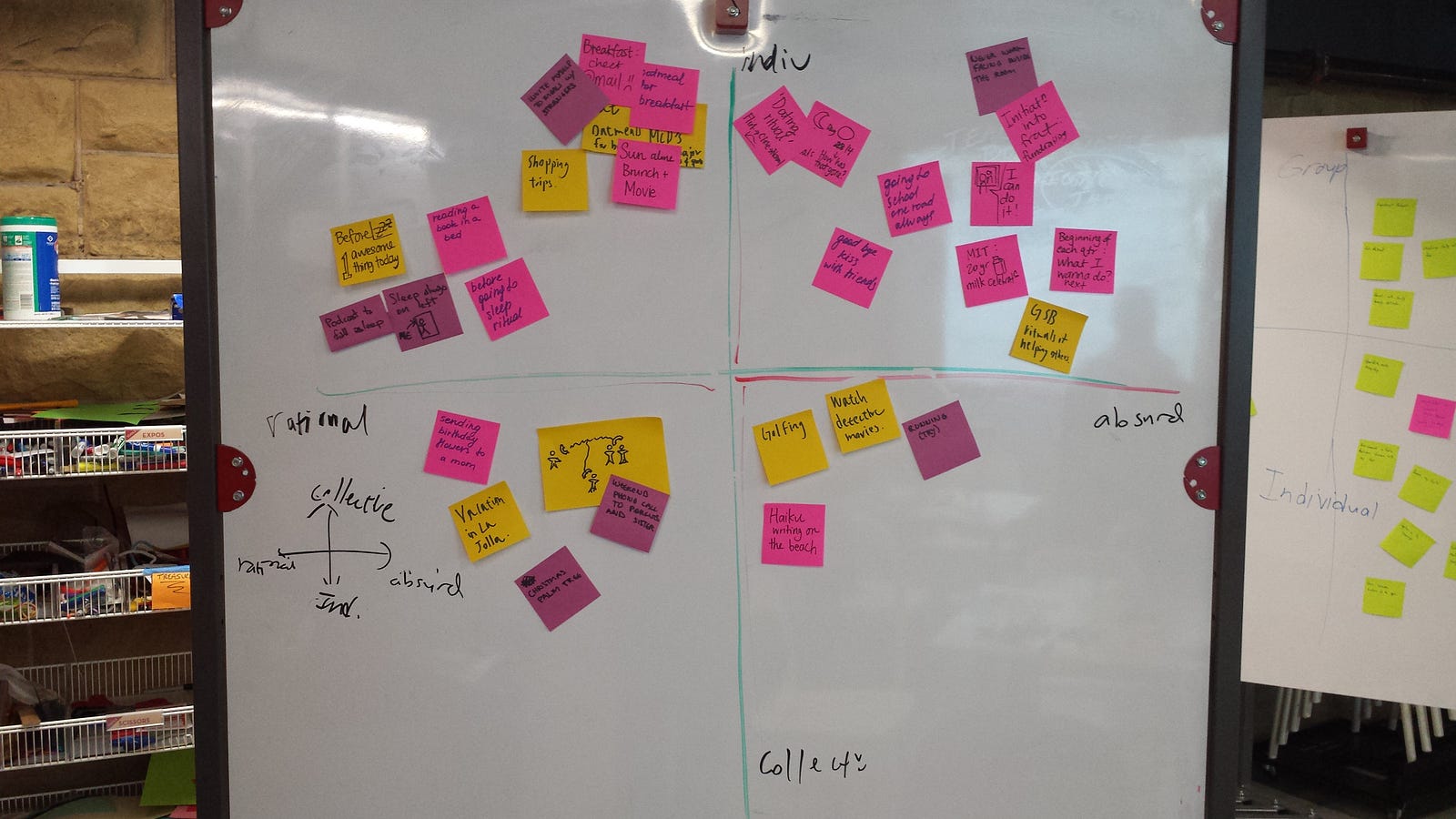
We are surrounded by all kinds of rituals, and they don’t exist in a vacuum. This exercise helps the participants to come to this realization. We gave people a timer and a prompt: create an inventory of all the active and past rituals in your life. They had to make a list (on individual post-its) of every ritual or ritual-like experience they could recall experiencing.
At the end of the inventory time, then we asked them to run a matrix exercise. They had to lay out the rituals in their inventory on a map of two axes — for example, individual to collective and profane to spiritual. Later in the design session, we asked them to revisit the ritual inventory and look for emotions and values that they can use in their new ritual.
Here are some of the rituals that we heard from the participants:
-Everyday at 11:11 pm, I have a 1 minute breathing ritual, I have a group of friends to remind each other.
-I make my bed every morning in a particular way to start the day with
-When I am working and messed things up, I take a walk to the water fountain, to calm things down.
-I carry a notebook that I barely use to make sure I am on my foot and thinking
-I carry a notebook, jot down the things I’m grateful for, and that brings joy.
-I’ve a leather bag with two pockets in front, whenever I close the latch, it means I am done with the day & tasks
Method 2. Ritual Improv: Improvise with constraints and discover what might stick
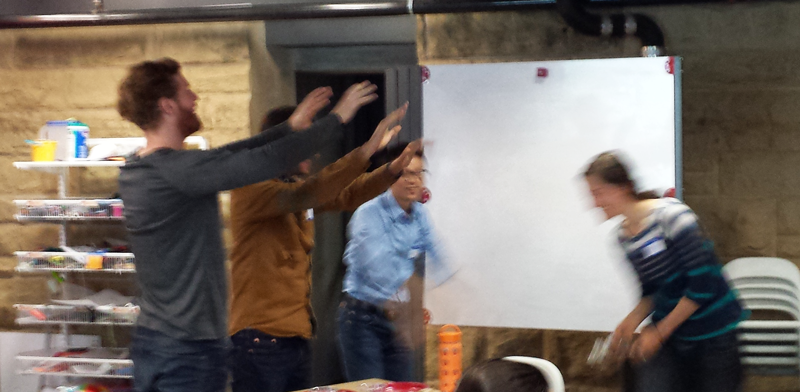
Ritual is a performance, and needs to be enacted in the process of designing it. In this exercise, we asked participants to take the props that they brought with them, and in a small group, act out a ritual around them. The goal was to use an improv spirit, a very short time constraint, and a general prompt (in this case, create a ‘welcoming ritual’) in order to generate some random, interesting new rituals.
During the improv session, we gave them constraints, and goals to boost the creativity in their improv exploration. At the end of the exercise, teams acted out their rituals in front of the class. This exercise helps participants to discover the randomness factor in rituals, and also experiment with the physical and emotional aspects of the props in a ritual.
Method 3. Map your routines and look for sweet spots

As we dove further into designing a ritual with the participants, we want to point out that designers cannot design an experience in a literal sense. Rather, designers create an experience frame for people to shape their own experiences. This kind of framework acts as a guidance for the participant to follow through with its affordances, constraints, goals, and mechanics.
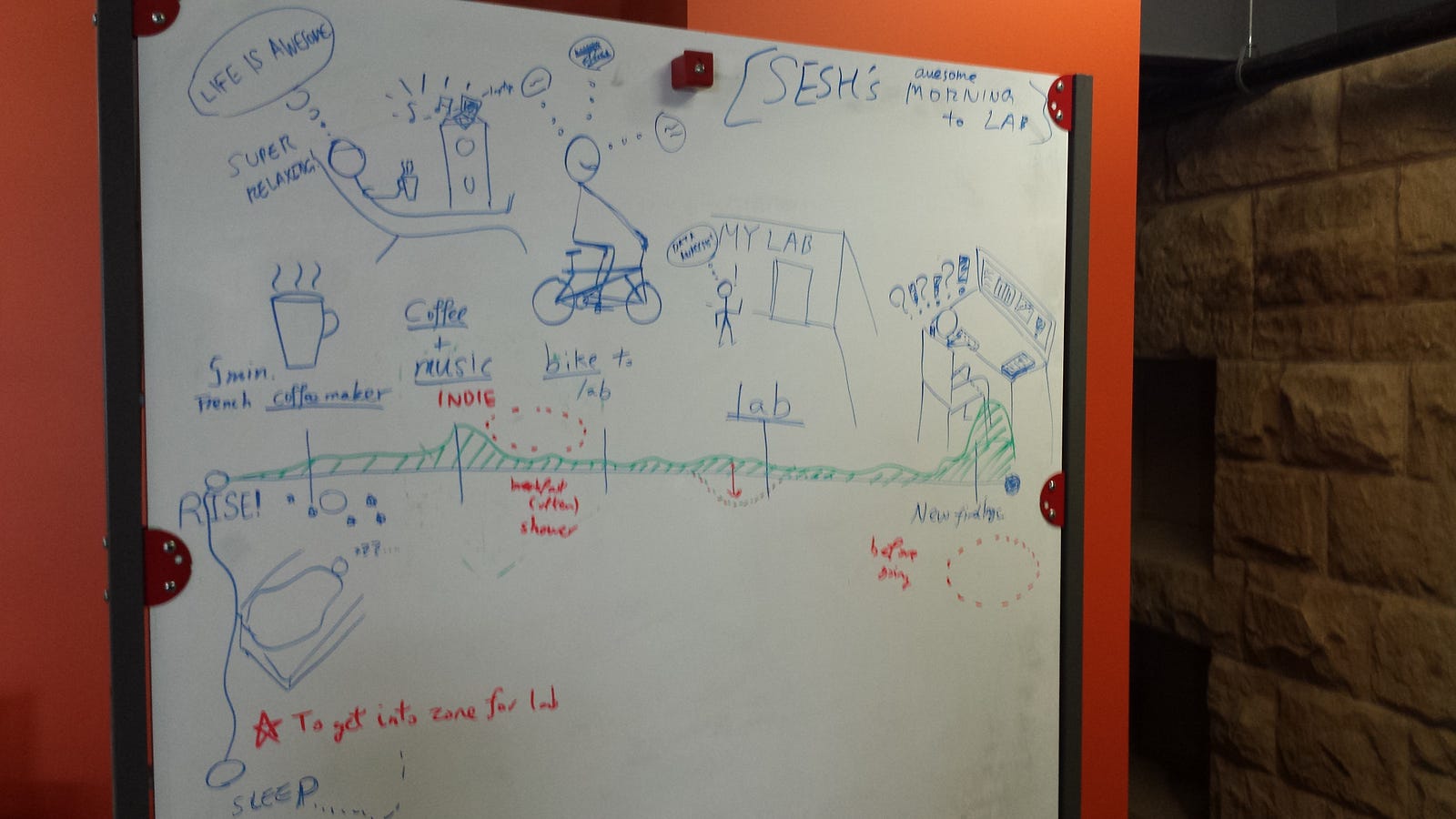
Having spent time on the inventory and improvisation of rituals, we asked participants to go deeper with their theme (food, commute, grooming, or productivity).
They first mapped out their daily routine around the theme they selected, and looked for possible sweet spots to design their ritual onto. Sweet spots could be a low-emotion or high-emotion point, where you want to capitalize on a great thing that’s happening or you want to intervene to make a bad situation better. It could also be a highly repetitive moment or act, where you see a chance to use this repetition for a ritual.
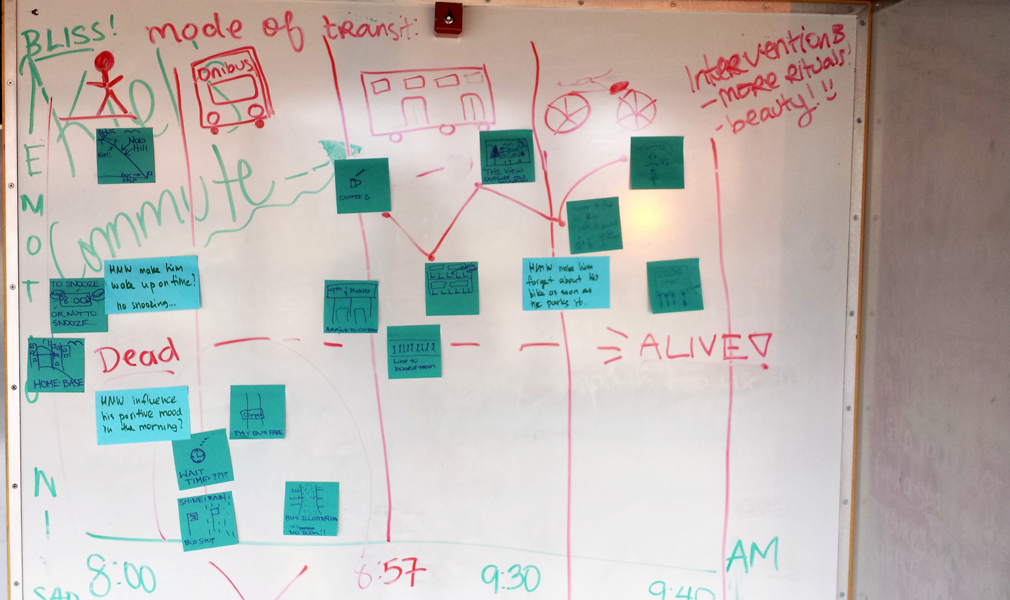
These sweet spots are then the jumping off point for an intentional ritual design process, in which the designer can purposefully try to choreograph a new ritual for that spot.
Method 4: Use Ritual Mechanics
We then introduced them to our ritual design framework, of ritual elements and mechanics, to guide the participants through creating a new food, commute, grooming, or productivity ritual for themselves (or a partner).
We created an initial ‘Ritual Design’ framework to help them explore how they might take their daily routines and make them more ritual experiences. The framework is a combination of elements (components that most any ritual should involve) and mechanics (how these elements combine to create the magic of rituals). There are five elements to a successful ritual: triggers, intention spell, script, enactment, and props. These five elements define a narrative arc and purpose for ritual. (a more detailed post on ritual mechanics is in the works!).
In the workshop, we provided these mechanics with maps, explanations, and templates. Then the participants used their routine map, props, improv methods to experiment with these elements. As they tried to figure out what kind of ritual might work, they went back and forth in small teams, performing improved scenes, sketching out what they might do, creating physical and spatial prototypes, and talking through possibilities. We encouraged active, group-based prototyping, to generate more sparks and randomness (without a person sitting down to think very logically about how to improve their own routine).
They experimented with the elements, and then enacted them in front of others to get their feedback. Once they ran through a possible ritual several times, they had to begin thinking through how they would define and capture their evolving ritual — in the form of a 1 minute video.
Ritual mechanics can be applied to design in three distinct ways:
- as a way to create new rituals;
- ritualizing existing experiences, adding greater meaning and depth to them; and
- designing of ritual artifacts in support of rituals. (We go into this framework in greater depth in our first post).
Method 5. Perform your ritual with video prototyping
The final piece of the workshop was capturing the ritual with video prototyping. The method helps the ritual designer to think about the experience along its full arc, as well as how its spark can be shown, and how a spectator would see it.
Each participant sketched out their ritual in a storyboard format, and invited others to be part of the ritual they designed. They used lightweight video capturing/editing tools on their smartphones, and developed 1 minute videos. For this part of the design phase, we encouraged participants to make use of music, and other sensory elements.
The Rituals Designed
So what did the participants actually create during the workshop? Here are a couple of selected rituals from each of the theme. Note that, these videos were created rapid fire style during class time.
The Cal(m)Train helps a daily Caltrain commuter to have a calm commuting experience by spending quality time with the people and the environment she loves before the actual commuting.
The Mud Shower Ritual helps a daily showering person to really feel cleaned by offering a mud shower before the actual shower. With this twist the person feels purified, and accomplished.
The Study Cube ritual helps a graduate student to focus on the study topic wherever he is by being the symbolic marker of the focused zone. With the help of a magic prop, the person feels empowered.
The Social Cooking ritual is a service offering where a person initiates a special dinner for a group of friends. Ritual service provides a cooking box with surprise ingredients that they need to make sense and cook a dish together. With the help of the challenge and creating a common goal, this ritual strengthens the bond between friends.
The Baby Gym is a ritual for young parents to reframe their baby-soothing routine into a healthy gym ritual. Parent can try different muscle sets by lifting the baby(biceps, triceps,etc), baby gets happier with different viewpoints.
Travel Connect is a content choreography app that makes your daily Caltrain commutes more meaningful. Depending on the time left for your ride, it gives you the right dose of prompts and content for reading, calling friends, etc.
Learnings
While preparing for the workshops, we had a hunch about who our audience would be, but we weren’t fully aware of the type of people who have an appetite for ritual design. Having worked with our participants in a short design sprint like this, we identified two distinct group of ritual design people: first, designers who have a deep yearning for more sensemaking and curious, almost spiritual moments, and second, life hackers coming from different disciplines who want to practically improve quality of their daily lives.
Here are some of our learnings for designers, and life hackers of all kind, about the potential and the methodology of ritual design:
1. Dig deeper to unveil values
To set the stage for ritual design, there are two things to be thinking of — the narrative arc of the ritual that you can script and choreograph, and the magic force of the ritual that can be a prop, an interaction, a word, movement, etc. That’s what we’re seeing as the core pattern of the ritual — the narrative arc and the magic force.
Our ritual design sessions showed that making a personal inventory of rituals is helpful to better understand the arc and the underlying values that you are designing for. An inventory of rituals can be further articulated with a laddering exercise where the designer asks ‘why’ questions to go deeper and unveil the values or emotions that the person cares about, that are underlying the rituals, and that have made them successful.
2. Balance intentionality & improvisation with a bias toward experimentation
Rituals are formed in two distinct ways — the intentional, and the in-the-moment. Some rituals are formed naturally as its participants enact, interpret and shape a happening into a more formal ritual over time. The sensemaking and ritual-defining happen in the moment, or sometimes after the ritual is over. Rituals can grow out of rewiring repetitive patterns or improvised actions into a more holistic experience, taking the in-the-moment activities and imbuing them with greater meaning.
The second formation is more intentional, and ‘designed.’ The designer of the ritual conceives of how the happenings should unfold, and then enacts them with the participants according to the designed plan. Sensemaking in this kind of ritual is usually projected with deliberate emotions or values. It’s up to the participants to take on and identify these emotions/values with themselves.
During our workshops, we experimented both with the improvised (or in-the-moment) and intentional approaches. One of the things we would do differently is to encourage more of the improvised rituals. Rather than trying to coldly plot out how meaning could arise or how magic can happen, ritual design should be about generating unseen connections, fostering the illogical and random, and encouraging the unusual. To get to these sparks, it’s hard to do with overly intentional planning, Experimentation, improvisation, and open-mindedness should drive the design effort.
3. Work with a partner to design a ritual for you
In the first version of our workshop, we asked the participants to design the ritual for themselves. In the second one, we had them in pairs, designing for each other. We observed that participants thought further out of the box when they were designing for someone else.
Letting someone else design the ritual for you, two things happen. First, you get a more objective and accurate representation of your daily routine. Someone else can see opportunities, connections, and sparks you may not.
Second, your partner brings their own inventory of rituals and inspiration to the design process, that can be a source of surprises and randomness that feed into successful rituals. And they have greater distance from your life, and can add healthy feedback and refinement to improve the quality of the design.
4. Anchor ritual improv to a specific context or mission
In our first round of our workshop, we ran ritual improv as a freeform exercise, without many props or constraints. This proved tough. It was hard both for us, the leaders, and the participants to grasp the fluid, loose nature of each of the small improv sprints and make sense of them.
In the second workshop, we tried something different. We did one round of improv, in which we gave them a specific context, such as coworking space for productivity theme; a hotel room for a grooming theme; snack at a coffeeshop for eating theme. Their group improvised rituals with this context as a constraint.
Having improvised in these contexts, we then introduced brands, like TechShop for productivity; Hyatt for grooming; and Starbucks for eating. Now their rituals were supposed to serve these brands — another constraint and mission. These specific points of guidance led to greater creativity, and more confidence in the improv. The participants were able to articulate the narrative arc that they were going after, and to reflect afterwards about the ritual they had created.
5. Aim for small moment rituals
Reflecting on the rituals that were created at the end of the two workshops, we discovered that there are almost as many personal rituals as social rituals.
Looking at the personal rituals, there is huge appetite for bringing more ritual into small everyday moments — commutes on the train, family dinners, taking a shower. This proved our initial assumption on the significance of small-r ritual design, aimed to create daily rituals that are lightweight, flexible, and craftable. We had proposed some themes — food, commuting, productivity, and grooming. All of the themes were popular, but food and commuting were particularly so.
These workshop series made it clear that ritual design could open up a space for more thoughtful approaches to meaning-making & magic that designers are going after in their work. The methods we picked and tested are familiar to the user experience communities. The add-on layer to these methods was our strong point of view on rituals. We will be testing and refining on these methods more on the upcoming months. Stay tuned!
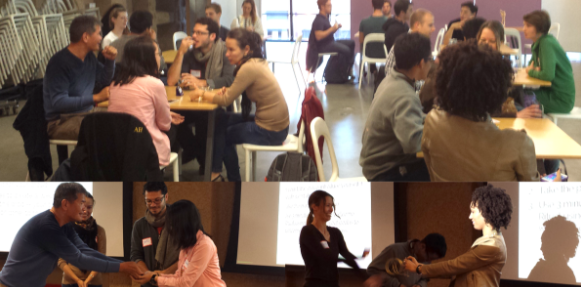
Comments 8
Why am I not able to see the 2 min ritual videos on this website
Author
Hi Veena, check the original Medium post, you can see videos there.
https://medium.com/stanford-d-school/how-do-you-design-a-ritual-e4aeb3e17198#.8lw09rwje
Pingback: A Design Lab Is Making Rituals for Secular People | Situs Agen Sbobet Judi Bola Casino Togel Online Terpercaya Indonesia & Cara Daftar Sbobet - link Alternatif Sbobet
Pingback: A Design Lab Is Making Rituals for Secular People - The Tech News
Pingback: A Design Lab Is Making Rituals for Secular People - lucklook.cf
Pingback: A Design Lab Is Making Rituals for Secular People - havie.cf
Pingback: A Design Lab Is Making Rituals for Secular People - havienews.cf
Pingback: Rite of inhabiting the in between – Mar de Fronteira